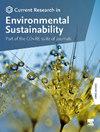Spatial variation of biochar production potential from surplus crop residues in India
IF 3.7
Q2 ENVIRONMENTAL SCIENCES
Current Research in Environmental Sustainability
Pub Date : 2025-01-01
DOI:10.1016/j.crsust.2025.100279
引用次数: 0
Abstract
India faces environmental issues due to large-scale seasonal in situ burning of crop residues, leading to air pollution and nutrient loss. Biochar application can increase soil carbon content, moisture, and nutrient content while reducing air pollution. India produces 156 Mt. of annual in situ surplus crop residues from ten major crops, with the highest potential for rice residue biomass in Sangrur, Punjab. Biochar could reduce greenhouse gas emissions by 405 Tg annually and its application to soil could sequester 7.5 Tg of carbon. However, competition between biochar and other crop residue management technologies requires a life cycle assessment for sustainable management.
求助全文
约1分钟内获得全文
求助全文
来源期刊

Current Research in Environmental Sustainability
Environmental Science-General Environmental Science
CiteScore
7.50
自引率
9.10%
发文量
76
审稿时长
95 days
 求助内容:
求助内容: 应助结果提醒方式:
应助结果提醒方式:


